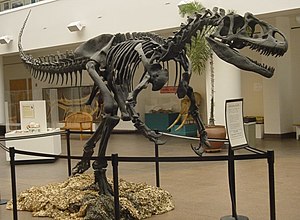Tetanurae
| Tetanurae | ||||||||||
|---|---|---|---|---|---|---|---|---|---|---|

Skeleton reconstruction of Allosaurus , a late Jurassic tetanure from North America |
||||||||||
| Temporal occurrence | ||||||||||
|
Lower Jurassic to Upper Cretaceous (birds until now ) |
||||||||||
| 201.3 to 66 (or 0) million years | ||||||||||
| Locations | ||||||||||
|
||||||||||
| Systematics | ||||||||||
|
||||||||||
| Scientific name | ||||||||||
| Tetanurae | ||||||||||
| Gauthier , 1986 |
The Tetanurae ("rigid tails") are a taxon (a natural kin) to which most theropod dinosaurs belong. Tetanurs appear for the first time in fossil form in the Lower Jurassic , and one of their groups, the birds , has survived to the present day.
A diagnostic feature is the elongation of the hand.
Systematics
-
Theropoda
- Ceratosauria
-
Tetanurae
- Xuanhanosaurus
- Spinosauroidea
- Tetanurae incertae sedis
- Avetheropoda
Spinosauroidea
→ Main article: Spinosauroidea
The Spinosauroidea are formed by the two families Megalosauridae and Spinosauridae . Characteristics of the skull and humerus in particular distinguish this group from other types of tetanurae. Most of the megalosaurids, which live in the Jurassic , were massive, while the skeletons of the spinosaurids, often found in Cretaceous rocks, have spinous processes on the vertebrae.
Carnosauria
→ Main article: Carnosauria
The Carnosauria are composed of different types and groups of dinosaurs. For example, they contain the Allosauroidea , which in turn are divided into Sinraptoridae , Allosauridae and Carcharodontosauridae . While the well-known Allosaurus from the late Jurassic belongs to the Allosauridae, some of the largest theropods such as the Giganotosaurus , Carcharodontosaurus or Mapusaurus belong to the Carcharodontosauridae.
Tyrannosauroidea
→ Main article: Tyrannosauroidea
The superfamily Tyrannosauroidea is formed from the two families Tyrannosauridae and Proceratosauridae and other genera. The Tyrannosauridae are formed by several, sometimes extremely large theropods such as Tyrannosaurus , Tarbosaurus , Albertosaurus or Daspletosaurus . In contrast, the rather unknown taxon Proceratosauridae consists of the two genera Proceratosaurus and Guanlong .
The tyrannosauroids appeared with rather small body dimensions 168 million years ago and disappeared with the rest of the dinosaurs (except the birds ) at the end of the Cretaceous period 66 million years ago.
Ornithomimosauria
→ Main article: Ornithomimosauria
In general, the dinosaurs belonging to the ornithomimosauria can be compared in their appearance with ostriches . They had rather small heads on their relatively long necks, had strong legs and were lightly built. Except for the early representatives of the ornithomimosaurs, they were toothless. The best known members of this group are the three ornithomimids Ornithomimus , Gallimimus and Struthiomimus . All three lived in the late Cretaceous until 66 million years ago.
Therizinosauroidea
→ Main article: Therizinosauroidea
Genera, which are counted to the Therizinosauroidea, were found in the rocks of North America and Asia and come from about 130 to 66 million years old layers . Their physique is most unusual for theropod dinosaurs. The most typical feature of this group are the extremely pronounced claws on the front extremities. In addition, these dinosaurs had a long neck on which a small skull sat. What they fed on is controversial among paleontologists . One assumption is that they were herbivores (herbivores).
Oviraptorosauria
→ Main article: Oviraptorosauria
The Oviraptorosauria contain one of the most famous dinosaurs in Asia, the Oviraptor . Fossils of other Oviraptorosaurs, which are related to the Oviraptor , were discovered not only in Asia, but also in North America. The size of the various genera belonging to this group varies greatly. The smallest, such as Caudipteryx, were no longer than a meter, the largest could reach eight times the length of Caudipteryx , in this regard Gigantoraptor should be mentioned.
Troodontidae
→ Main article: Troodontidae
The genera belonging to the Troodontidae are the most intelligent of all dinosaurs (with the exception of the bird dinosaurs) in terms of brain volume. Another characteristic are the very large eyes with which the troodontids could see spatially, as they were directed forward. The best known Troodontidae is Troodon . Like all other troodontids, it had a sickle claw on each foot. In terms of food, it is believed that the tiny dinosaurs ate insects or other small animals, as well as eggs.
Dromaeosauridae
→ Main article: Dromaeosauridae
The Dromaeosauridae encompass very many genera, the fossils of which have been found in almost all parts of the world . They all had two sizeable sickle claws on their feet. In terms of size, there were both small and large genera within the Dromaeosauridae. The most famous representatives include the Velociraptor and the Dromaeosaurus . The approximately three meter long Deinonychus can also be described as popular.
The first dromaeosaurids appeared in the middle Jurassic 168 million years ago and disappeared 66 million years ago at the end of the Cretaceous .
literature
- Reinhard Rieger , Wilfried Westheide (ed.): Special zoology. Part 2: vertebrates or skulls. Fischer u. a., Stuttgart a. a. 2004, ISBN 3-8274-0900-4 .
- David B. Weishampel , Peter Dodson , Halszka Osmólska (eds.): The Dinosauria . 2nd edition. University of California Press, Berkeley CA et al. a. 2004, ISBN 0-520-24209-2 .



